Weimin Tan
Scaling Laws for Data-Efficient Visual Transfer Learning
Apr 17, 2025Abstract:Current scaling laws for visual AI models focus predominantly on large-scale pretraining, leaving a critical gap in understanding how performance scales for data-constrained downstream tasks. To address this limitation, this paper establishes the first practical framework for data-efficient scaling laws in visual transfer learning, addressing two fundamental questions: 1) How do scaling behaviors shift when downstream tasks operate with limited data? 2) What governs the efficacy of knowledge distillation under such constraints? Through systematic analysis of vision tasks across data regimes (1K-1M samples), we propose the distillation boundary theory, revealing a critical turning point in distillation efficiency: 1) Distillation superiority: In data-scarce conditions, distilled models significantly outperform their non-distillation counterparts, efficiently leveraging inherited knowledge to compensate for limited training samples. 2) Pre-training dominance: As pre-training data increases beyond a critical threshold, non-distilled models gradually surpass distilled versions, suggesting diminishing returns from knowledge inheritance when sufficient task-specific data becomes available. Empirical validation across various model scales (2.5M to 38M parameters) and data volumes demonstrate these performance inflection points, with error difference curves transitioning from positive to negative values at critical data thresholds, confirming our theoretical predictions. This work redefines scaling laws for data-limited regimes, bridging the knowledge gap between large-scale pretraining and practical downstream adaptation, addressing a critical barrier to understanding vision model scaling behaviors and optimizing computational resource allocation.
Non-Uniform Class-Wise Coreset Selection: Characterizing Category Difficulty for Data-Efficient Transfer Learning
Apr 17, 2025Abstract:As transfer learning models and datasets grow larger, efficient adaptation and storage optimization have become critical needs. Coreset selection addresses these challenges by identifying and retaining the most informative samples, constructing a compact subset for target domain training. However, current methods primarily rely on instance-level difficulty assessments, overlooking crucial category-level characteristics and consequently under-representing minority classes. To overcome this limitation, we propose Non-Uniform Class-Wise Coreset Selection (NUCS), a novel framework that integrates both class-level and instance-level criteria. NUCS automatically allocates data selection budgets for each class based on intrinsic category difficulty and adaptively selects samples within optimal difficulty ranges. By explicitly incorporating category-specific insights, our approach achieves a more balanced and representative coreset, addressing key shortcomings of prior methods. Comprehensive theoretical analysis validates the rationale behind adaptive budget allocation and sample selection, while extensive experiments across 14 diverse datasets and model architectures demonstrate NUCS's consistent improvements over state-of-the-art methods, achieving superior accuracy and computational efficiency. Notably, on CIFAR100 and Food101, NUCS matches full-data training accuracy while retaining just 30% of samples and reducing computation time by 60%. Our work highlights the importance of characterizing category difficulty in coreset selection, offering a robust and data-efficient solution for transfer learning.
FacialFlowNet: Advancing Facial Optical Flow Estimation with a Diverse Dataset and a Decomposed Model
Sep 09, 2024Abstract:Facial movements play a crucial role in conveying altitude and intentions, and facial optical flow provides a dynamic and detailed representation of it. However, the scarcity of datasets and a modern baseline hinders the progress in facial optical flow research. This paper proposes FacialFlowNet (FFN), a novel large-scale facial optical flow dataset, and the Decomposed Facial Flow Model (DecFlow), the first method capable of decomposing facial flow. FFN comprises 9,635 identities and 105,970 image pairs, offering unprecedented diversity for detailed facial and head motion analysis. DecFlow features a facial semantic-aware encoder and a decomposed flow decoder, excelling in accurately estimating and decomposing facial flow into head and expression components. Comprehensive experiments demonstrate that FFN significantly enhances the accuracy of facial flow estimation across various optical flow methods, achieving up to an 11% reduction in Endpoint Error (EPE) (from 3.91 to 3.48). Moreover, DecFlow, when coupled with FFN, outperforms existing methods in both synthetic and real-world scenarios, enhancing facial expression analysis. The decomposed expression flow achieves a substantial accuracy improvement of 18% (from 69.1% to 82.1%) in micro-expressions recognition. These contributions represent a significant advancement in facial motion analysis and optical flow estimation. Codes and datasets can be found.
Maximizing V-information for Pre-training Superior Foundation Models
Aug 13, 2024Abstract:Pre-training foundation models on large-scale datasets demonstrates exceptional performance. However, recent research questions this traditional notion, exploring whether an increase in pre-training data always leads to enhanced model performance. To address this issue, data-effective learning approaches have been introduced. However, current methods in this area lack a clear standard for sample selection. Our experiments reveal that by maximizing V-information, sample selection can be framed as an optimization problem, enabling effective improvement in model performance even with fewer samples. Under this guidance, we develop an optimal data-effective learning method (OptiDEL) to maximize V-information. The OptiDEL method generates hard samples to achieve or even exceed the performance of models trained on the full dataset while using substantially less data. We compare the OptiDEL method with state-of-the-art approaches finding that OptiDEL consistently outperforms existing approaches across different datasets, with foundation models trained on only 5% of the pre-training data surpassing the performance of those trained on the full dataset.
Addressing Imbalance for Class Incremental Learning in Medical Image Classification
Jul 18, 2024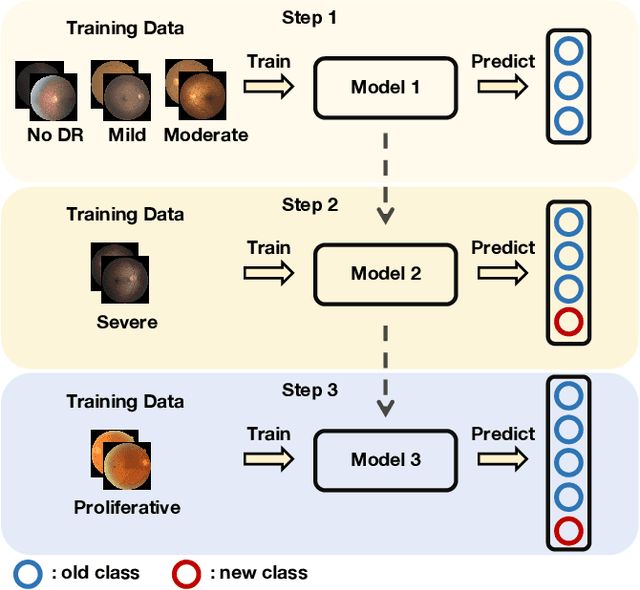
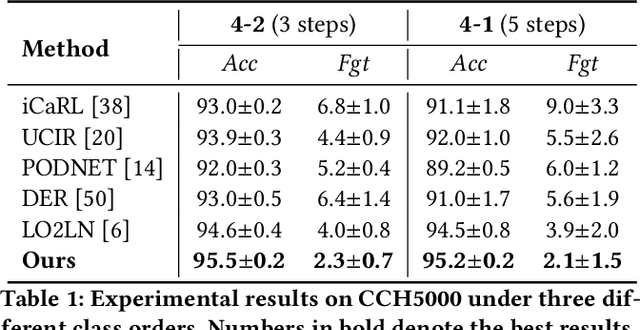
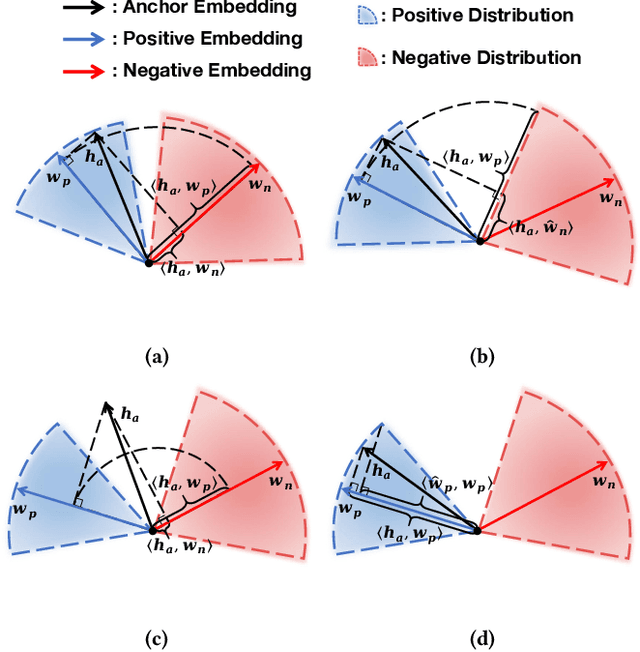
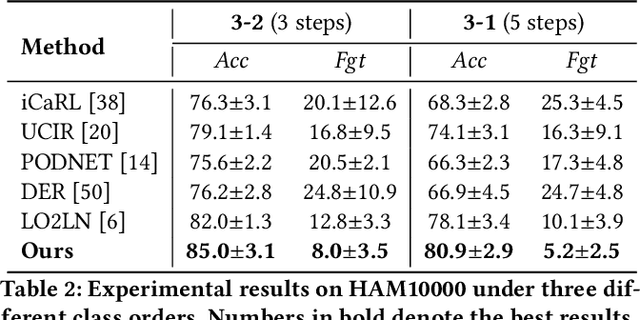
Abstract:Deep convolutional neural networks have made significant breakthroughs in medical image classification, under the assumption that training samples from all classes are simultaneously available. However, in real-world medical scenarios, there's a common need to continuously learn about new diseases, leading to the emerging field of class incremental learning (CIL) in the medical domain. Typically, CIL suffers from catastrophic forgetting when trained on new classes. This phenomenon is mainly caused by the imbalance between old and new classes, and it becomes even more challenging with imbalanced medical datasets. In this work, we introduce two simple yet effective plug-in methods to mitigate the adverse effects of the imbalance. First, we propose a CIL-balanced classification loss to mitigate the classifier bias toward majority classes via logit adjustment. Second, we propose a distribution margin loss that not only alleviates the inter-class overlap in embedding space but also enforces the intra-class compactness. We evaluate the effectiveness of our method with extensive experiments on three benchmark datasets (CCH5000, HAM10000, and EyePACS). The results demonstrate that our approach outperforms state-of-the-art methods.
Data-Effective Learning: A Comprehensive Medical Benchmark
Jan 31, 2024Abstract:Data-effective learning aims to use data in the most impactful way to train AI models, which involves strategies that focus on data quality rather than quantity, ensuring the data used for training has high informational value. Data-effective learning plays a profound role in accelerating AI training, reducing computational costs, and saving data storage, which is very important as the volume of medical data in recent years has grown beyond many people's expectations. However, due to the lack of standards and comprehensive benchmark, research on medical data-effective learning is poorly studied. To address this gap, our paper introduces a comprehensive benchmark specifically for evaluating data-effective learning in the medical field. This benchmark includes a dataset with millions of data samples from 31 medical centers (DataDEL), a baseline method for comparison (MedDEL), and a new evaluation metric (NormDEL) to objectively measure data-effective learning performance. Our extensive experimental results show the baseline MedDEL can achieve performance comparable to the original large dataset with only 5% of the data. Establishing such an open data-effective learning benchmark is crucial for the medical AI research community because it facilitates efficient data use, promotes collaborative breakthroughs, and fosters the development of cost-effective, scalable, and impactful healthcare solutions. The project can be accessed at https://github.com/shadow2469/Data-Effective-Learning-A-Comprehensive-Medical-Benchmark.git.
Low-latency Space-time Supersampling for Real-time Rendering
Dec 18, 2023Abstract:With the rise of real-time rendering and the evolution of display devices, there is a growing demand for post-processing methods that offer high-resolution content in a high frame rate. Existing techniques often suffer from quality and latency issues due to the disjointed treatment of frame supersampling and extrapolation. In this paper, we recognize the shared context and mechanisms between frame supersampling and extrapolation, and present a novel framework, Space-time Supersampling (STSS). By integrating them into a unified framework, STSS can improve the overall quality with lower latency. To implement an efficient architecture, we treat the aliasing and warping holes unified as reshading regions and put forth two key components to compensate the regions, namely Random Reshading Masking (RRM) and Efficient Reshading Module (ERM). Extensive experiments demonstrate that our approach achieves superior visual fidelity compared to state-of-the-art (SOTA) methods. Notably, the performance is achieved within only 4ms, saving up to 75\% of time against the conventional two-stage pipeline that necessitates 17ms.
Context-Aware Iteration Policy Network for Efficient Optical Flow Estimation
Dec 14, 2023Abstract:Existing recurrent optical flow estimation networks are computationally expensive since they use a fixed large number of iterations to update the flow field for each sample. An efficient network should skip iterations when the flow improvement is limited. In this paper, we develop a Context-Aware Iteration Policy Network for efficient optical flow estimation, which determines the optimal number of iterations per sample. The policy network achieves this by learning contextual information to realize whether flow improvement is bottlenecked or minimal. On the one hand, we use iteration embedding and historical hidden cell, which include previous iterations information, to convey how flow has changed from previous iterations. On the other hand, we use the incremental loss to make the policy network implicitly perceive the magnitude of optical flow improvement in the subsequent iteration. Furthermore, the computational complexity in our dynamic network is controllable, allowing us to satisfy various resource preferences with a single trained model. Our policy network can be easily integrated into state-of-the-art optical flow networks. Extensive experiments show that our method maintains performance while reducing FLOPs by about 40%/20% for the Sintel/KITTI datasets.
Unsupervised Disentangling of Facial Representations with 3D-aware Latent Diffusion Models
Sep 15, 2023
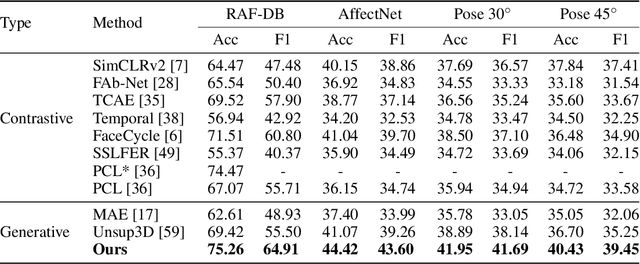
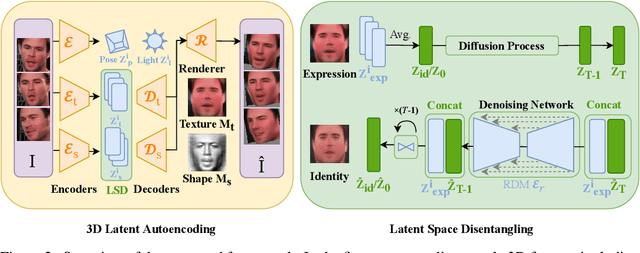
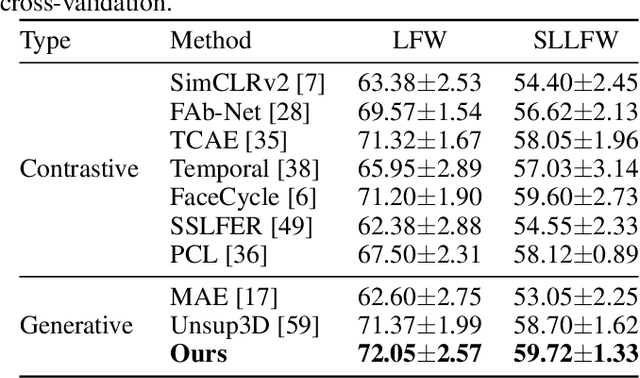
Abstract:Unsupervised learning of facial representations has gained increasing attention for face understanding ability without heavily relying on large-scale annotated datasets. However, it remains unsolved due to the coupling of facial identities, expressions, and external factors like pose and light. Prior methods primarily focus on 2D factors and pixel-level consistency, leading to incomplete disentangling and suboptimal performance in downstream tasks. In this paper, we propose LatentFace, a novel unsupervised disentangling framework for facial expression and identity representation. We suggest the disentangling problem should be performed in latent space and propose the solution using a 3D-ware latent diffusion model. First, we introduce a 3D-aware autoencoder to encode face images into 3D latent embeddings. Second, we propose a novel representation diffusion model (RDM) to disentangle 3D latent into facial identity and expression. Consequently, our method achieves state-of-the-art performance in facial expression recognition and face verification among unsupervised facial representation learning models.
SAMFlow: Eliminating Any Fragmentation in Optical Flow with Segment Anything Model
Aug 16, 2023Abstract:Optical Flow Estimation aims to find the 2D dense motion field between two frames. Due to the limitation of model structures and training datasets, existing methods often rely too much on local clues and ignore the integrity of objects, resulting in fragmented motion estimation. Through theoretical analysis, we find the pre-trained large vision models are helpful in optical flow estimation, and we notice that the recently famous Segment Anything Model (SAM) demonstrates a strong ability to segment complete objects, which is suitable for solving the fragmentation problem. We thus propose a solution to embed the frozen SAM image encoder into FlowFormer to enhance object perception. To address the challenge of in-depth utilizing SAM in non-segmentation tasks like optical flow estimation, we propose an Optical Flow Task-Specific Adaption scheme, including a Context Fusion Module to fuse the SAM encoder with the optical flow context encoder, and a Context Adaption Module to adapt the SAM features for optical flow task with Learned Task-Specific Embedding. Our proposed SAMFlow model reaches 0.86/2.10 clean/final EPE and 3.55/12.32 EPE/F1-all on Sintel and KITTI-15 training set, surpassing Flowformer by 8.5%/9.9% and 13.2%/16.3%. Furthermore, our model achieves state-of-the-art performance on the Sintel and KITTI-15 benchmarks, ranking #1 among all two-frame methods on Sintel clean pass.
 Add to Chrome
Add to Chrome Add to Firefox
Add to Firefox Add to Edge
Add to Edge